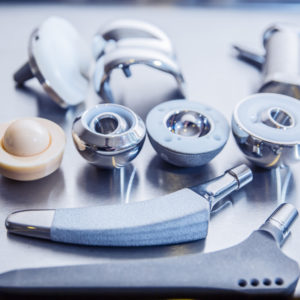Biomet Settlements for Revised M2A Magnum Hip Replacements Moving Forward in MDL

Progress continues to be made toward settling Biomet M2A hip replacement lawsuits brought on behalf of individuals who required revision surgery due to problems with the metal-on-metal implant.
Earlier this year, a Biomet settlement was announced in cases brought by individuals who received an M2A Magnum hip replacement, which has been linked to complications caused by the release of metallic debris as the metal components rub against each other.
Most of the cases are consolidated in the U.S. District Court for the Northern District of Indiana, where more than 2,400 complaints are centralized before U.S. District Judge Robert L. Miller as part of an MDL, or multidistrict litigation.

Learn More About
Lawsuits are being reviewed for several different dangerous and defective hip replacement systems.
Learn More About this Lawsuit SEE IF YOU QUALIFY FOR COMPENSATIONThe settlement only applies to claims for plaintiffs who received a Biomet M2a 38 or M2a Magnum implant as part of an initial hip replacement that was revised within 180 days. Under terms of the agreement, individuals who have not yet required revision surgery will still be able to pursue a claim if their hip replacement fails in the future.
Settlement Status in Biomet MDL
In a joint status report (PDF) submitted on September 17, the parties updated Judge Miller on progress in the settlement.
Eligible cases have been broken down into two groups, with 513 “Group 1” cases where plaintiffs had materially completed all discovery requirements in their case prior to December 31, 2013. Another 972 claims are considered “Group 2” cases, where materially completed plaintiff fact sheets were provided between January 1, 2014 and June 13, 2014. Although the agreement set a deadline of June 13 for submissions, Biomet indicates in the update that it is continuing to review and analyze plaintiff fact sheets submitted after that date.
Under terms of the settlement, each eligible claimant will receive a base amount of $200,000, with other factors impacting the individual award, such as the amount of time between the original surgery and revision date, the type of implant used and when the artificial hip was sold. A process was also established for plaintiffs to pursue possible enhanced compensation through a mediation process, which is on-going in Group 1 cases.
Late last week, plaintiffs asked Judge Miller to establish a qualified settlement fund and appoint a fund administrator (PDF) to help finalize the settlements, allowing for the allocation and final disbursement of funds.
Biomet Hip Replacement Revisions
The Biomet M2a is a metal-on-metal artificial hip replacement system, which plaintiffs allege was defectively designed and prone to fail prematurely, resulting in the need for revision surgery to replace the implant.
Lawsuits allege that the Biomet hip design causes excessive amounts of cobalt and chromium to corrode and wear from the surfaces of the acetabular cup, femoral head and taper sleeve as the metal parts rub against each other. This excessive wear may result in loosening and instability within a few years after the artificial hip is implanted.
The settlement does not include claims filed by plaintiffs who have not required revision surgery as a result of their problems with Biomet M2a Magnum hip replacements.
On September 12, a joint stipulation to dismiss non-revision cases (PDF) was filed by the parties, identifying 388 cases filed in the MDL that have been stayed as non-revision cases, where there is no pending motion to life that non-revision stay.
Pursuant to the agreement, individuals who require a subsequent revision surgery can refile their claims in the future, as Biomet agreed to recognized that the Statute of Limitations will be triggered at the time of revision.
Metal-on-Metal Hip Problems
Biomet is just one of a number of medical device manufacturers facing similar hip lawsuits over metal-on-metal designs, which became highly popular several years ago, before they were linked to problems with metal blood poisoning, tumors and tissue death as a result of chromium and cobalt debris that may be released as the metal ball and socket joints rub against each other during normal use.
DePuy Orthopaedic, a Johnson & Johnson subsidiary, has agreed to pay at least $2.4 billion to settle similar claims involving its ASR hip implant, which was recalled due to high failure rates in August 2010. At least 12,000 DePuy ASR hip lawsuits were filed by individuals who received the implant prior to the recall.
That manufacturer also faces more than 6,500 Depuy Pinnacle metal hip lawsuits, involving an earlier version of the implant that features a similar metal-on-metal design.
The first Depuy Pinnacle hip trial is currently on-going in the U.S. District Court for the Northern District of Texas. The so-called bellwether trial is being closely monitored, as it may serve as a test case to gauge how juries may respond to similar evidence and testimony that would be repeated other claims.
While the outcome will not be binding in other cases, it may facilitate DePuy Pinnacle hip settlements to avoid the need for thousands of individual cases to be set for trial nationwide.
Get more articles like this sent directly to your inbox.
"*" indicates required fields






0 Comments